Business Law Assignment
VerifiedAdded on 2023/06/10
|8
|1926
|224
AI Summary
The article discusses the essential elements of a valid contract and the doctrine of promissory estoppel. It applies these concepts to two case studies and provides a conclusion based on the analysis.
Contribute Materials
Your contribution can guide someone’s learning journey. Share your
documents today.
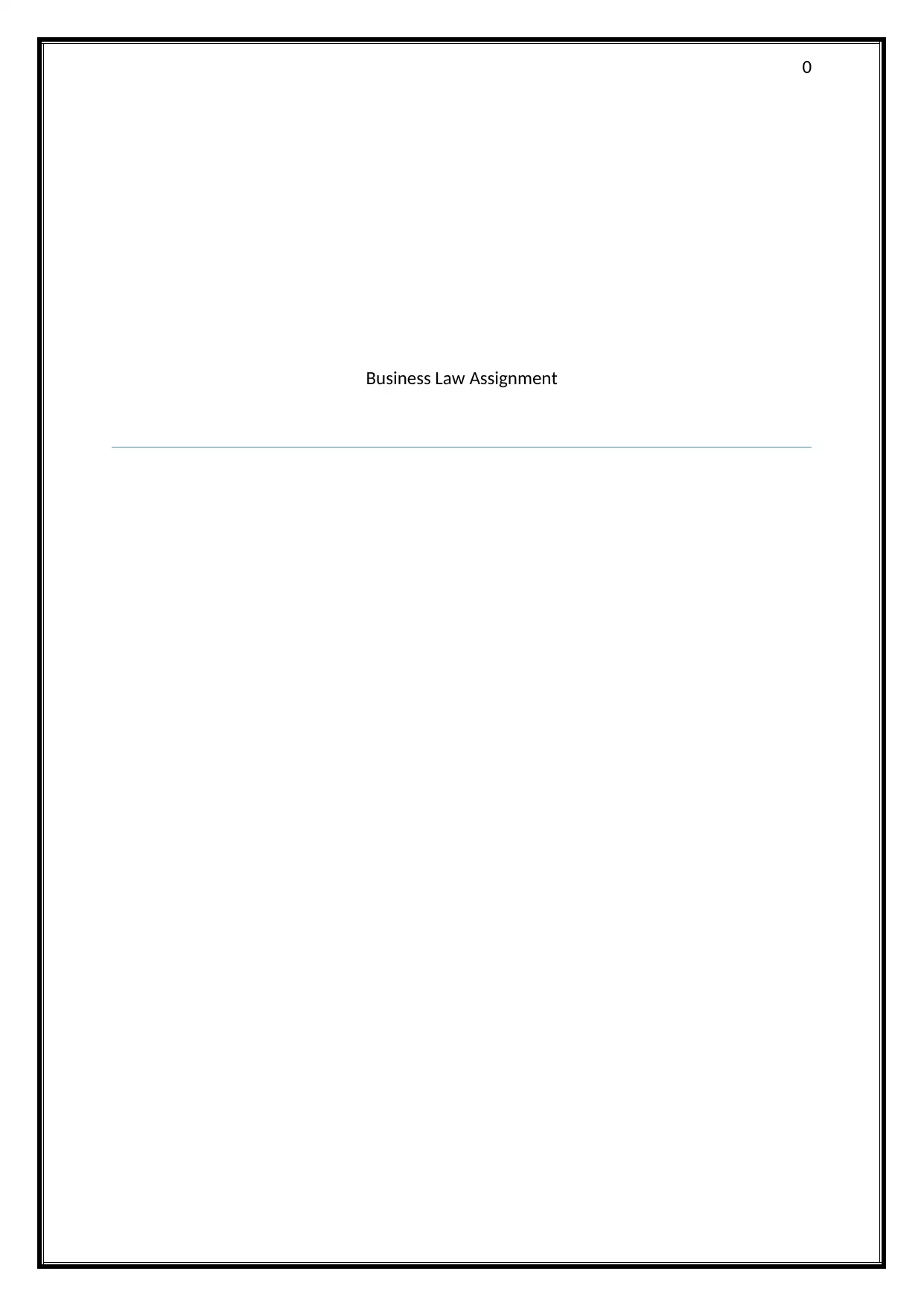
0
Business Law Assignment
Business Law Assignment
Secure Best Marks with AI Grader
Need help grading? Try our AI Grader for instant feedback on your assignments.
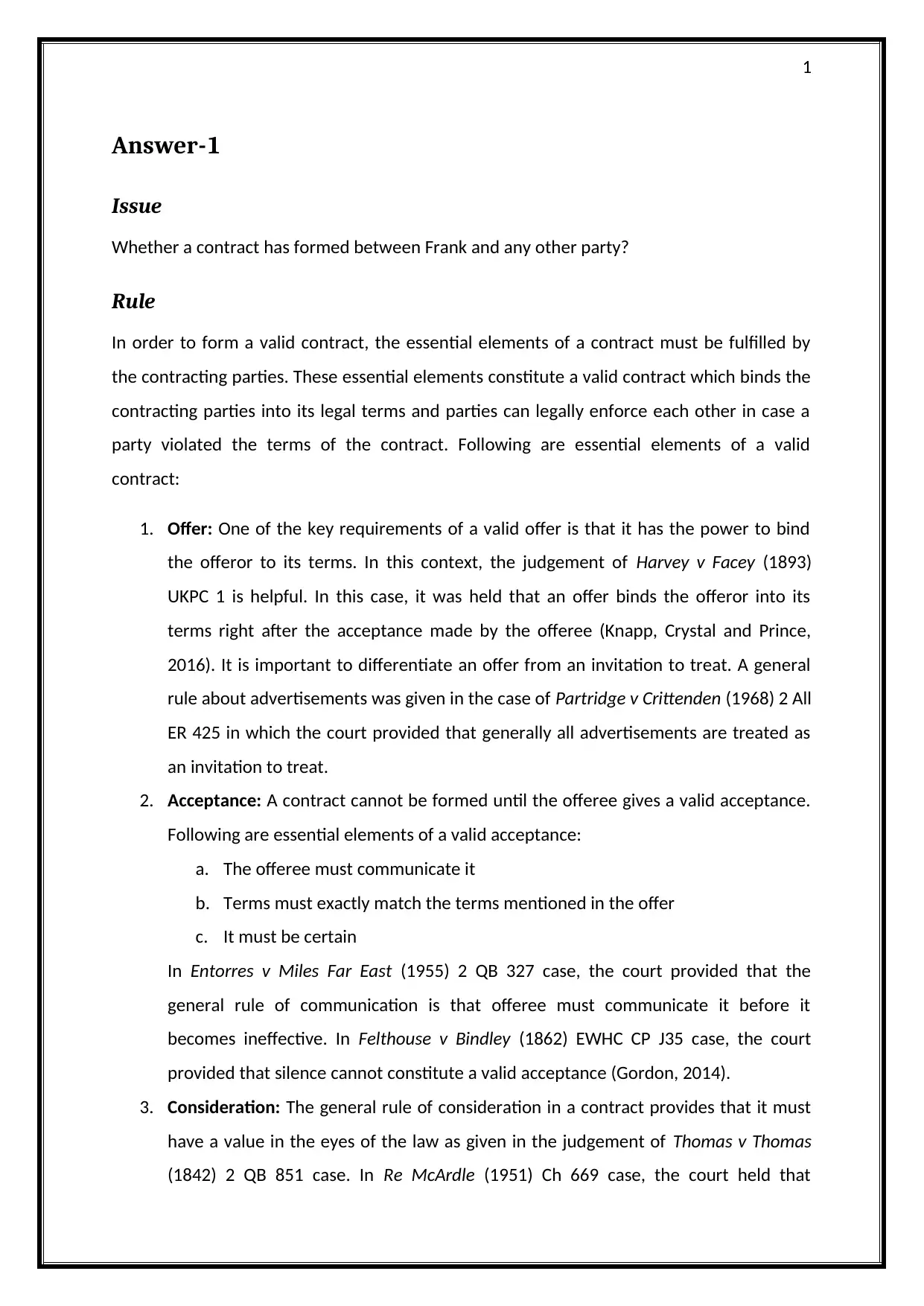
1
Answer-1
Issue
Whether a contract has formed between Frank and any other party?
Rule
In order to form a valid contract, the essential elements of a contract must be fulfilled by
the contracting parties. These essential elements constitute a valid contract which binds the
contracting parties into its legal terms and parties can legally enforce each other in case a
party violated the terms of the contract. Following are essential elements of a valid
contract:
1. Offer: One of the key requirements of a valid offer is that it has the power to bind
the offeror to its terms. In this context, the judgement of Harvey v Facey (1893)
UKPC 1 is helpful. In this case, it was held that an offer binds the offeror into its
terms right after the acceptance made by the offeree (Knapp, Crystal and Prince,
2016). It is important to differentiate an offer from an invitation to treat. A general
rule about advertisements was given in the case of Partridge v Crittenden (1968) 2 All
ER 425 in which the court provided that generally all advertisements are treated as
an invitation to treat.
2. Acceptance: A contract cannot be formed until the offeree gives a valid acceptance.
Following are essential elements of a valid acceptance:
a. The offeree must communicate it
b. Terms must exactly match the terms mentioned in the offer
c. It must be certain
In Entorres v Miles Far East (1955) 2 QB 327 case, the court provided that the
general rule of communication is that offeree must communicate it before it
becomes ineffective. In Felthouse v Bindley (1862) EWHC CP J35 case, the court
provided that silence cannot constitute a valid acceptance (Gordon, 2014).
3. Consideration: The general rule of consideration in a contract provides that it must
have a value in the eyes of the law as given in the judgement of Thomas v Thomas
(1842) 2 QB 851 case. In Re McArdle (1951) Ch 669 case, the court held that
Answer-1
Issue
Whether a contract has formed between Frank and any other party?
Rule
In order to form a valid contract, the essential elements of a contract must be fulfilled by
the contracting parties. These essential elements constitute a valid contract which binds the
contracting parties into its legal terms and parties can legally enforce each other in case a
party violated the terms of the contract. Following are essential elements of a valid
contract:
1. Offer: One of the key requirements of a valid offer is that it has the power to bind
the offeror to its terms. In this context, the judgement of Harvey v Facey (1893)
UKPC 1 is helpful. In this case, it was held that an offer binds the offeror into its
terms right after the acceptance made by the offeree (Knapp, Crystal and Prince,
2016). It is important to differentiate an offer from an invitation to treat. A general
rule about advertisements was given in the case of Partridge v Crittenden (1968) 2 All
ER 425 in which the court provided that generally all advertisements are treated as
an invitation to treat.
2. Acceptance: A contract cannot be formed until the offeree gives a valid acceptance.
Following are essential elements of a valid acceptance:
a. The offeree must communicate it
b. Terms must exactly match the terms mentioned in the offer
c. It must be certain
In Entorres v Miles Far East (1955) 2 QB 327 case, the court provided that the
general rule of communication is that offeree must communicate it before it
becomes ineffective. In Felthouse v Bindley (1862) EWHC CP J35 case, the court
provided that silence cannot constitute a valid acceptance (Gordon, 2014).
3. Consideration: The general rule of consideration in a contract provides that it must
have a value in the eyes of the law as given in the judgement of Thomas v Thomas
(1842) 2 QB 851 case. In Re McArdle (1951) Ch 669 case, the court held that
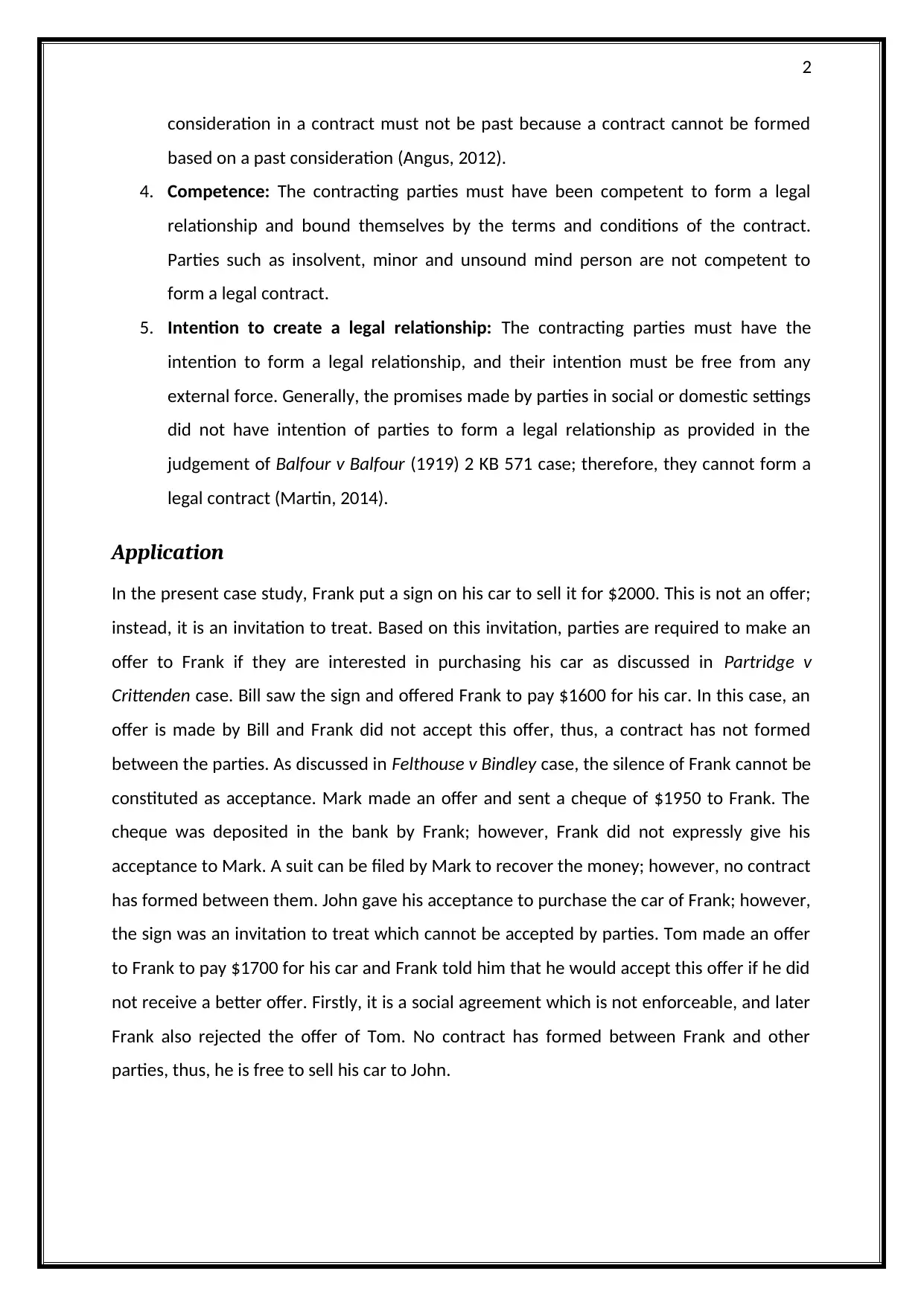
2
consideration in a contract must not be past because a contract cannot be formed
based on a past consideration (Angus, 2012).
4. Competence: The contracting parties must have been competent to form a legal
relationship and bound themselves by the terms and conditions of the contract.
Parties such as insolvent, minor and unsound mind person are not competent to
form a legal contract.
5. Intention to create a legal relationship: The contracting parties must have the
intention to form a legal relationship, and their intention must be free from any
external force. Generally, the promises made by parties in social or domestic settings
did not have intention of parties to form a legal relationship as provided in the
judgement of Balfour v Balfour (1919) 2 KB 571 case; therefore, they cannot form a
legal contract (Martin, 2014).
Application
In the present case study, Frank put a sign on his car to sell it for $2000. This is not an offer;
instead, it is an invitation to treat. Based on this invitation, parties are required to make an
offer to Frank if they are interested in purchasing his car as discussed in Partridge v
Crittenden case. Bill saw the sign and offered Frank to pay $1600 for his car. In this case, an
offer is made by Bill and Frank did not accept this offer, thus, a contract has not formed
between the parties. As discussed in Felthouse v Bindley case, the silence of Frank cannot be
constituted as acceptance. Mark made an offer and sent a cheque of $1950 to Frank. The
cheque was deposited in the bank by Frank; however, Frank did not expressly give his
acceptance to Mark. A suit can be filed by Mark to recover the money; however, no contract
has formed between them. John gave his acceptance to purchase the car of Frank; however,
the sign was an invitation to treat which cannot be accepted by parties. Tom made an offer
to Frank to pay $1700 for his car and Frank told him that he would accept this offer if he did
not receive a better offer. Firstly, it is a social agreement which is not enforceable, and later
Frank also rejected the offer of Tom. No contract has formed between Frank and other
parties, thus, he is free to sell his car to John.
consideration in a contract must not be past because a contract cannot be formed
based on a past consideration (Angus, 2012).
4. Competence: The contracting parties must have been competent to form a legal
relationship and bound themselves by the terms and conditions of the contract.
Parties such as insolvent, minor and unsound mind person are not competent to
form a legal contract.
5. Intention to create a legal relationship: The contracting parties must have the
intention to form a legal relationship, and their intention must be free from any
external force. Generally, the promises made by parties in social or domestic settings
did not have intention of parties to form a legal relationship as provided in the
judgement of Balfour v Balfour (1919) 2 KB 571 case; therefore, they cannot form a
legal contract (Martin, 2014).
Application
In the present case study, Frank put a sign on his car to sell it for $2000. This is not an offer;
instead, it is an invitation to treat. Based on this invitation, parties are required to make an
offer to Frank if they are interested in purchasing his car as discussed in Partridge v
Crittenden case. Bill saw the sign and offered Frank to pay $1600 for his car. In this case, an
offer is made by Bill and Frank did not accept this offer, thus, a contract has not formed
between the parties. As discussed in Felthouse v Bindley case, the silence of Frank cannot be
constituted as acceptance. Mark made an offer and sent a cheque of $1950 to Frank. The
cheque was deposited in the bank by Frank; however, Frank did not expressly give his
acceptance to Mark. A suit can be filed by Mark to recover the money; however, no contract
has formed between them. John gave his acceptance to purchase the car of Frank; however,
the sign was an invitation to treat which cannot be accepted by parties. Tom made an offer
to Frank to pay $1700 for his car and Frank told him that he would accept this offer if he did
not receive a better offer. Firstly, it is a social agreement which is not enforceable, and later
Frank also rejected the offer of Tom. No contract has formed between Frank and other
parties, thus, he is free to sell his car to John.
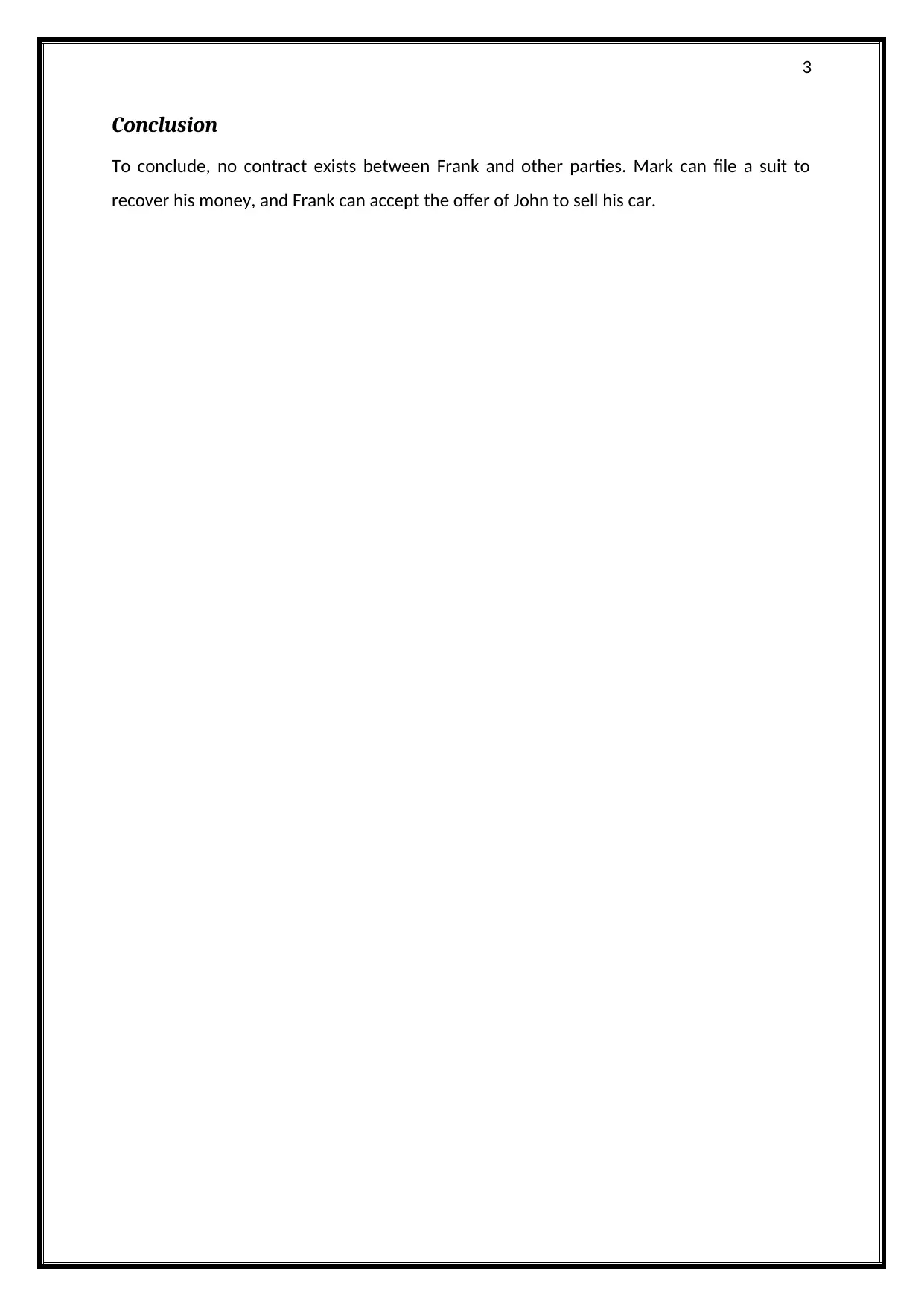
3
Conclusion
To conclude, no contract exists between Frank and other parties. Mark can file a suit to
recover his money, and Frank can accept the offer of John to sell his car.
Conclusion
To conclude, no contract exists between Frank and other parties. Mark can file a suit to
recover his money, and Frank can accept the offer of John to sell his car.
Secure Best Marks with AI Grader
Need help grading? Try our AI Grader for instant feedback on your assignments.
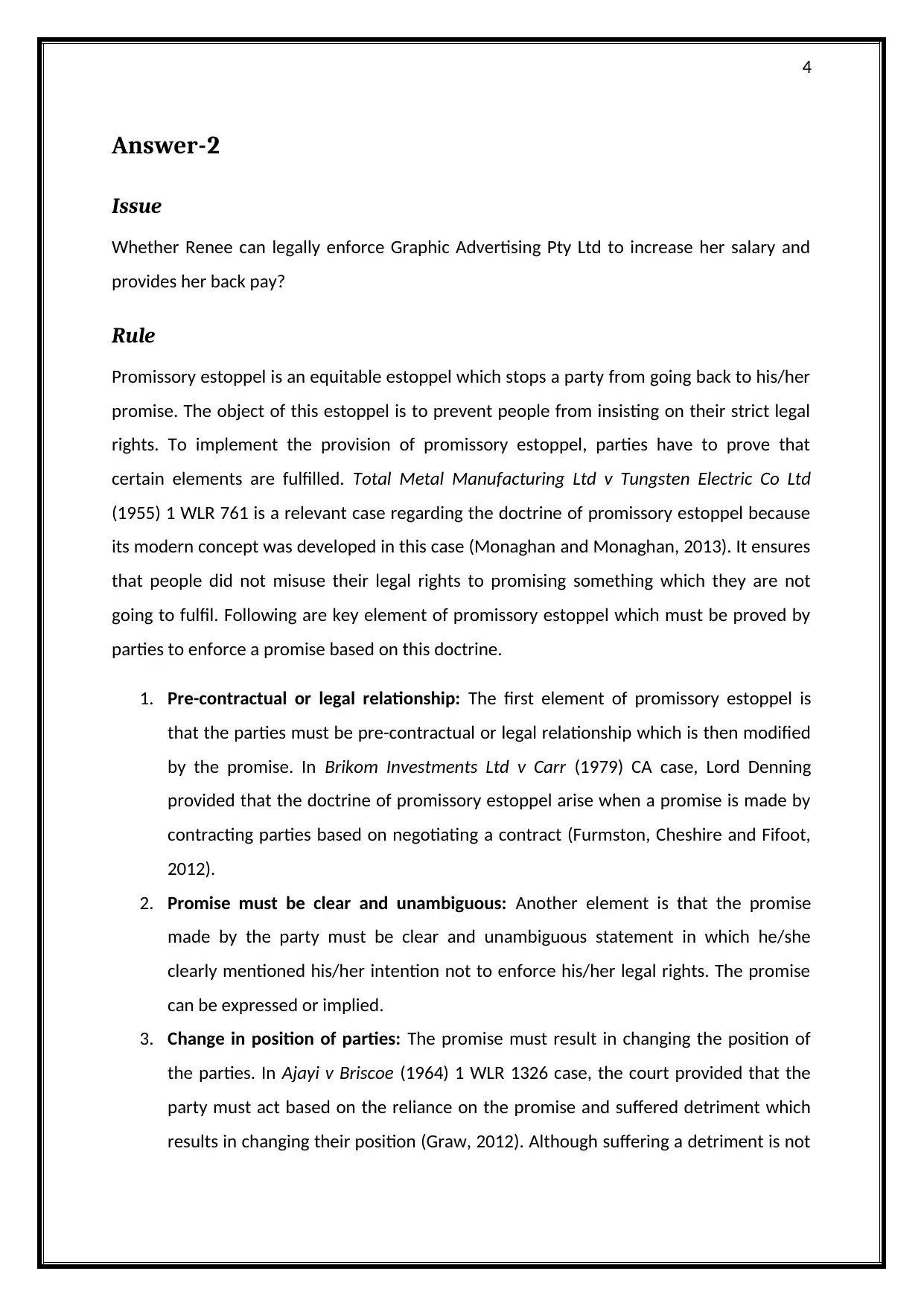
4
Answer-2
Issue
Whether Renee can legally enforce Graphic Advertising Pty Ltd to increase her salary and
provides her back pay?
Rule
Promissory estoppel is an equitable estoppel which stops a party from going back to his/her
promise. The object of this estoppel is to prevent people from insisting on their strict legal
rights. To implement the provision of promissory estoppel, parties have to prove that
certain elements are fulfilled. Total Metal Manufacturing Ltd v Tungsten Electric Co Ltd
(1955) 1 WLR 761 is a relevant case regarding the doctrine of promissory estoppel because
its modern concept was developed in this case (Monaghan and Monaghan, 2013). It ensures
that people did not misuse their legal rights to promising something which they are not
going to fulfil. Following are key element of promissory estoppel which must be proved by
parties to enforce a promise based on this doctrine.
1. Pre-contractual or legal relationship: The first element of promissory estoppel is
that the parties must be pre-contractual or legal relationship which is then modified
by the promise. In Brikom Investments Ltd v Carr (1979) CA case, Lord Denning
provided that the doctrine of promissory estoppel arise when a promise is made by
contracting parties based on negotiating a contract (Furmston, Cheshire and Fifoot,
2012).
2. Promise must be clear and unambiguous: Another element is that the promise
made by the party must be clear and unambiguous statement in which he/she
clearly mentioned his/her intention not to enforce his/her legal rights. The promise
can be expressed or implied.
3. Change in position of parties: The promise must result in changing the position of
the parties. In Ajayi v Briscoe (1964) 1 WLR 1326 case, the court provided that the
party must act based on the reliance on the promise and suffered detriment which
results in changing their position (Graw, 2012). Although suffering a detriment is not
Answer-2
Issue
Whether Renee can legally enforce Graphic Advertising Pty Ltd to increase her salary and
provides her back pay?
Rule
Promissory estoppel is an equitable estoppel which stops a party from going back to his/her
promise. The object of this estoppel is to prevent people from insisting on their strict legal
rights. To implement the provision of promissory estoppel, parties have to prove that
certain elements are fulfilled. Total Metal Manufacturing Ltd v Tungsten Electric Co Ltd
(1955) 1 WLR 761 is a relevant case regarding the doctrine of promissory estoppel because
its modern concept was developed in this case (Monaghan and Monaghan, 2013). It ensures
that people did not misuse their legal rights to promising something which they are not
going to fulfil. Following are key element of promissory estoppel which must be proved by
parties to enforce a promise based on this doctrine.
1. Pre-contractual or legal relationship: The first element of promissory estoppel is
that the parties must be pre-contractual or legal relationship which is then modified
by the promise. In Brikom Investments Ltd v Carr (1979) CA case, Lord Denning
provided that the doctrine of promissory estoppel arise when a promise is made by
contracting parties based on negotiating a contract (Furmston, Cheshire and Fifoot,
2012).
2. Promise must be clear and unambiguous: Another element is that the promise
made by the party must be clear and unambiguous statement in which he/she
clearly mentioned his/her intention not to enforce his/her legal rights. The promise
can be expressed or implied.
3. Change in position of parties: The promise must result in changing the position of
the parties. In Ajayi v Briscoe (1964) 1 WLR 1326 case, the court provided that the
party must act based on the reliance on the promise and suffered detriment which
results in changing their position (Graw, 2012). Although suffering a detriment is not
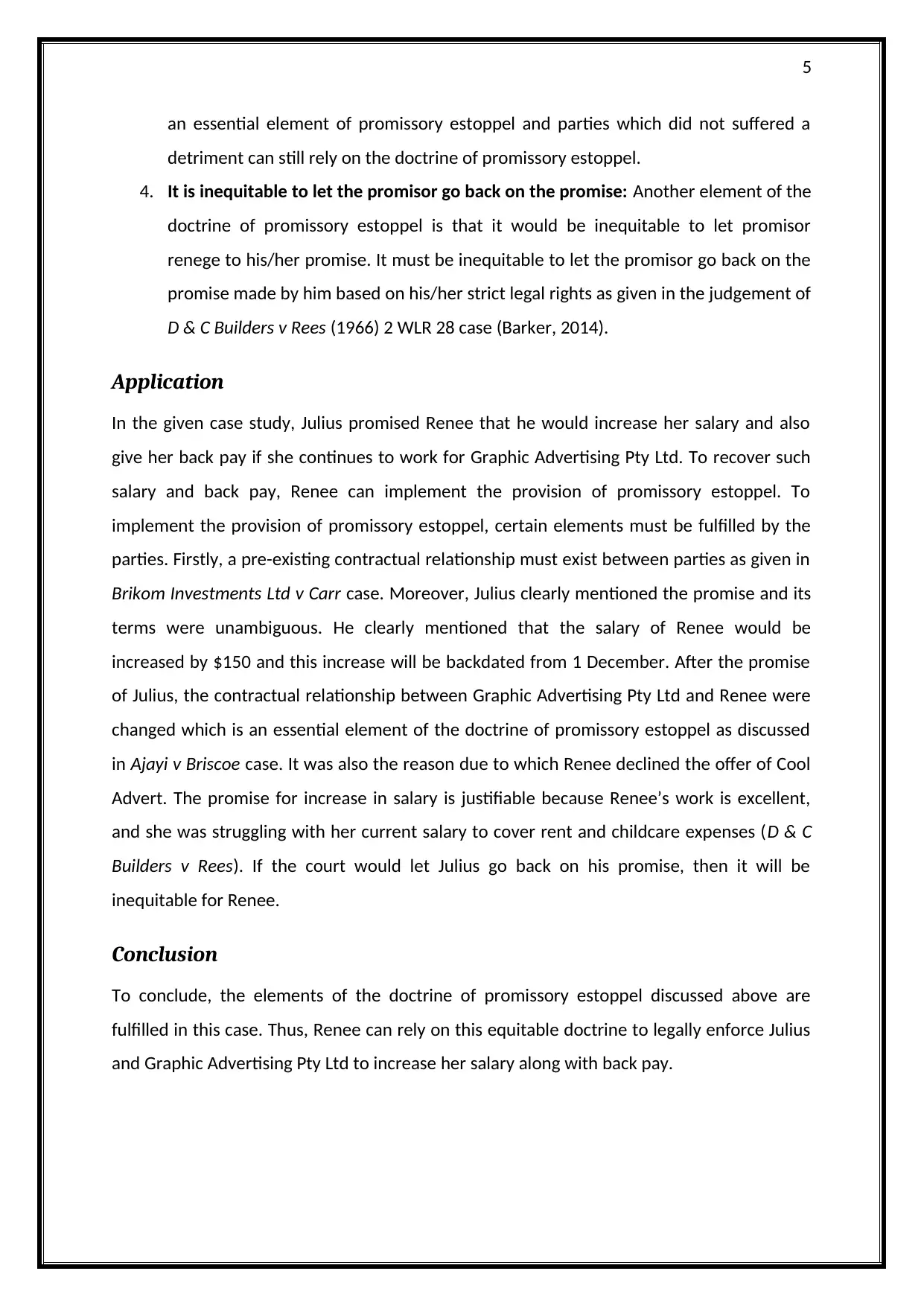
5
an essential element of promissory estoppel and parties which did not suffered a
detriment can still rely on the doctrine of promissory estoppel.
4. It is inequitable to let the promisor go back on the promise: Another element of the
doctrine of promissory estoppel is that it would be inequitable to let promisor
renege to his/her promise. It must be inequitable to let the promisor go back on the
promise made by him based on his/her strict legal rights as given in the judgement of
D & C Builders v Rees (1966) 2 WLR 28 case (Barker, 2014).
Application
In the given case study, Julius promised Renee that he would increase her salary and also
give her back pay if she continues to work for Graphic Advertising Pty Ltd. To recover such
salary and back pay, Renee can implement the provision of promissory estoppel. To
implement the provision of promissory estoppel, certain elements must be fulfilled by the
parties. Firstly, a pre-existing contractual relationship must exist between parties as given in
Brikom Investments Ltd v Carr case. Moreover, Julius clearly mentioned the promise and its
terms were unambiguous. He clearly mentioned that the salary of Renee would be
increased by $150 and this increase will be backdated from 1 December. After the promise
of Julius, the contractual relationship between Graphic Advertising Pty Ltd and Renee were
changed which is an essential element of the doctrine of promissory estoppel as discussed
in Ajayi v Briscoe case. It was also the reason due to which Renee declined the offer of Cool
Advert. The promise for increase in salary is justifiable because Renee’s work is excellent,
and she was struggling with her current salary to cover rent and childcare expenses (D & C
Builders v Rees). If the court would let Julius go back on his promise, then it will be
inequitable for Renee.
Conclusion
To conclude, the elements of the doctrine of promissory estoppel discussed above are
fulfilled in this case. Thus, Renee can rely on this equitable doctrine to legally enforce Julius
and Graphic Advertising Pty Ltd to increase her salary along with back pay.
an essential element of promissory estoppel and parties which did not suffered a
detriment can still rely on the doctrine of promissory estoppel.
4. It is inequitable to let the promisor go back on the promise: Another element of the
doctrine of promissory estoppel is that it would be inequitable to let promisor
renege to his/her promise. It must be inequitable to let the promisor go back on the
promise made by him based on his/her strict legal rights as given in the judgement of
D & C Builders v Rees (1966) 2 WLR 28 case (Barker, 2014).
Application
In the given case study, Julius promised Renee that he would increase her salary and also
give her back pay if she continues to work for Graphic Advertising Pty Ltd. To recover such
salary and back pay, Renee can implement the provision of promissory estoppel. To
implement the provision of promissory estoppel, certain elements must be fulfilled by the
parties. Firstly, a pre-existing contractual relationship must exist between parties as given in
Brikom Investments Ltd v Carr case. Moreover, Julius clearly mentioned the promise and its
terms were unambiguous. He clearly mentioned that the salary of Renee would be
increased by $150 and this increase will be backdated from 1 December. After the promise
of Julius, the contractual relationship between Graphic Advertising Pty Ltd and Renee were
changed which is an essential element of the doctrine of promissory estoppel as discussed
in Ajayi v Briscoe case. It was also the reason due to which Renee declined the offer of Cool
Advert. The promise for increase in salary is justifiable because Renee’s work is excellent,
and she was struggling with her current salary to cover rent and childcare expenses (D & C
Builders v Rees). If the court would let Julius go back on his promise, then it will be
inequitable for Renee.
Conclusion
To conclude, the elements of the doctrine of promissory estoppel discussed above are
fulfilled in this case. Thus, Renee can rely on this equitable doctrine to legally enforce Julius
and Graphic Advertising Pty Ltd to increase her salary along with back pay.
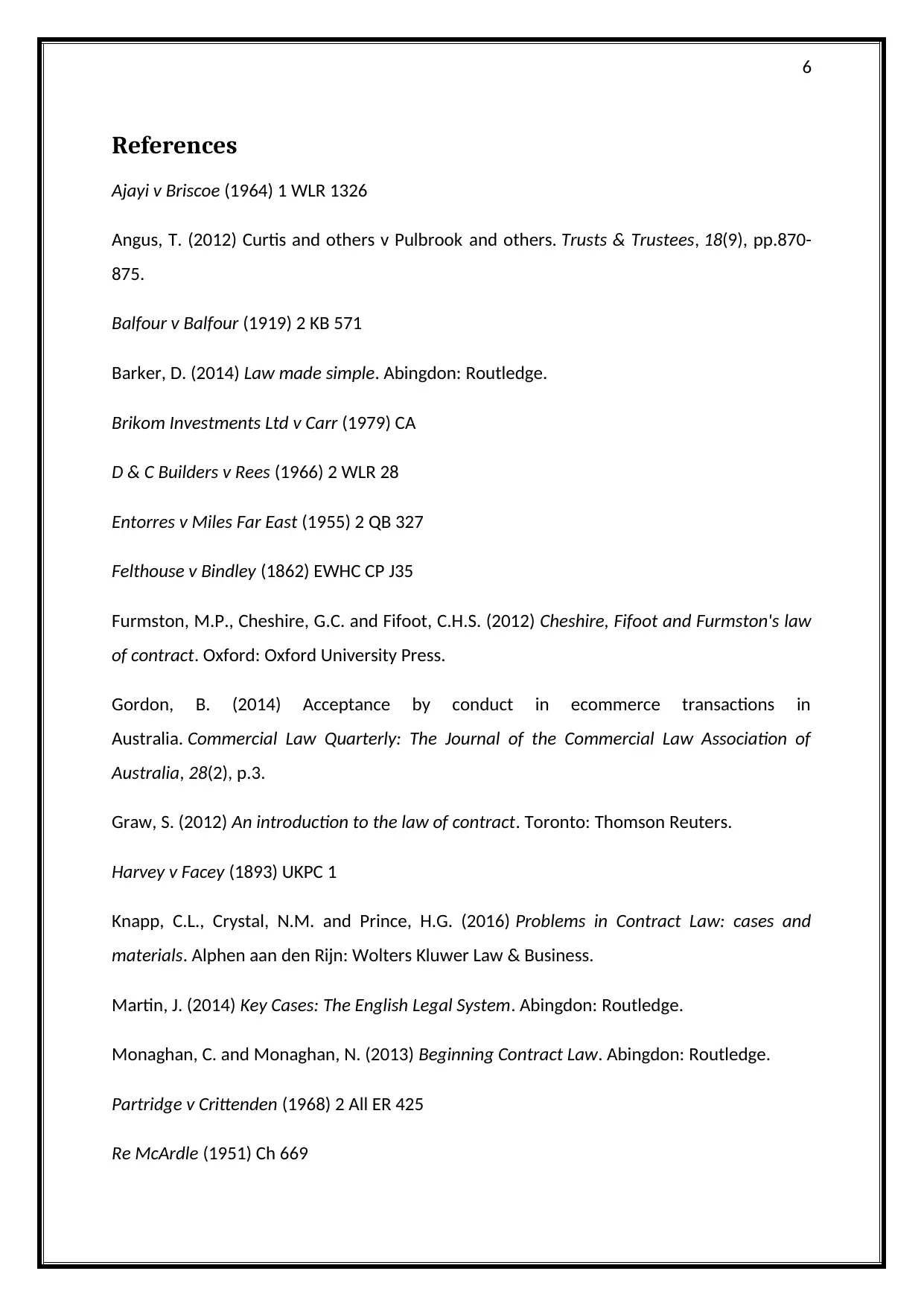
6
References
Ajayi v Briscoe (1964) 1 WLR 1326
Angus, T. (2012) Curtis and others v Pulbrook and others. Trusts & Trustees, 18(9), pp.870-
875.
Balfour v Balfour (1919) 2 KB 571
Barker, D. (2014) Law made simple. Abingdon: Routledge.
Brikom Investments Ltd v Carr (1979) CA
D & C Builders v Rees (1966) 2 WLR 28
Entorres v Miles Far East (1955) 2 QB 327
Felthouse v Bindley (1862) EWHC CP J35
Furmston, M.P., Cheshire, G.C. and Fifoot, C.H.S. (2012) Cheshire, Fifoot and Furmston's law
of contract. Oxford: Oxford University Press.
Gordon, B. (2014) Acceptance by conduct in ecommerce transactions in
Australia. Commercial Law Quarterly: The Journal of the Commercial Law Association of
Australia, 28(2), p.3.
Graw, S. (2012) An introduction to the law of contract. Toronto: Thomson Reuters.
Harvey v Facey (1893) UKPC 1
Knapp, C.L., Crystal, N.M. and Prince, H.G. (2016) Problems in Contract Law: cases and
materials. Alphen aan den Rijn: Wolters Kluwer Law & Business.
Martin, J. (2014) Key Cases: The English Legal System. Abingdon: Routledge.
Monaghan, C. and Monaghan, N. (2013) Beginning Contract Law. Abingdon: Routledge.
Partridge v Crittenden (1968) 2 All ER 425
Re McArdle (1951) Ch 669
References
Ajayi v Briscoe (1964) 1 WLR 1326
Angus, T. (2012) Curtis and others v Pulbrook and others. Trusts & Trustees, 18(9), pp.870-
875.
Balfour v Balfour (1919) 2 KB 571
Barker, D. (2014) Law made simple. Abingdon: Routledge.
Brikom Investments Ltd v Carr (1979) CA
D & C Builders v Rees (1966) 2 WLR 28
Entorres v Miles Far East (1955) 2 QB 327
Felthouse v Bindley (1862) EWHC CP J35
Furmston, M.P., Cheshire, G.C. and Fifoot, C.H.S. (2012) Cheshire, Fifoot and Furmston's law
of contract. Oxford: Oxford University Press.
Gordon, B. (2014) Acceptance by conduct in ecommerce transactions in
Australia. Commercial Law Quarterly: The Journal of the Commercial Law Association of
Australia, 28(2), p.3.
Graw, S. (2012) An introduction to the law of contract. Toronto: Thomson Reuters.
Harvey v Facey (1893) UKPC 1
Knapp, C.L., Crystal, N.M. and Prince, H.G. (2016) Problems in Contract Law: cases and
materials. Alphen aan den Rijn: Wolters Kluwer Law & Business.
Martin, J. (2014) Key Cases: The English Legal System. Abingdon: Routledge.
Monaghan, C. and Monaghan, N. (2013) Beginning Contract Law. Abingdon: Routledge.
Partridge v Crittenden (1968) 2 All ER 425
Re McArdle (1951) Ch 669
Paraphrase This Document
Need a fresh take? Get an instant paraphrase of this document with our AI Paraphraser
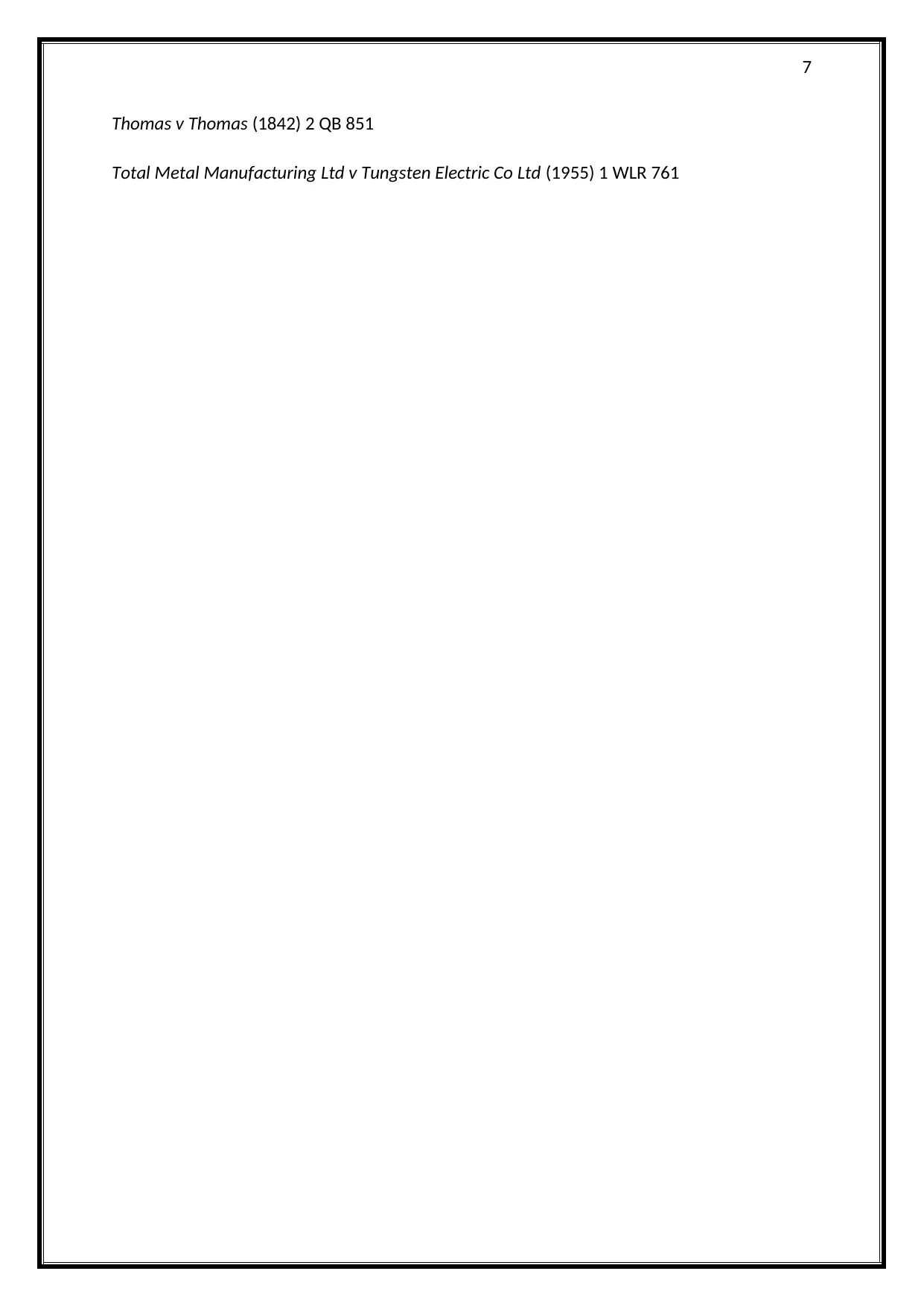
7
Thomas v Thomas (1842) 2 QB 851
Total Metal Manufacturing Ltd v Tungsten Electric Co Ltd (1955) 1 WLR 761
Thomas v Thomas (1842) 2 QB 851
Total Metal Manufacturing Ltd v Tungsten Electric Co Ltd (1955) 1 WLR 761
1 out of 8
Related Documents
Your All-in-One AI-Powered Toolkit for Academic Success.
+13062052269
info@desklib.com
Available 24*7 on WhatsApp / Email
![[object Object]](/_next/static/media/star-bottom.7253800d.svg)
Unlock your academic potential
© 2024 | Zucol Services PVT LTD | All rights reserved.





